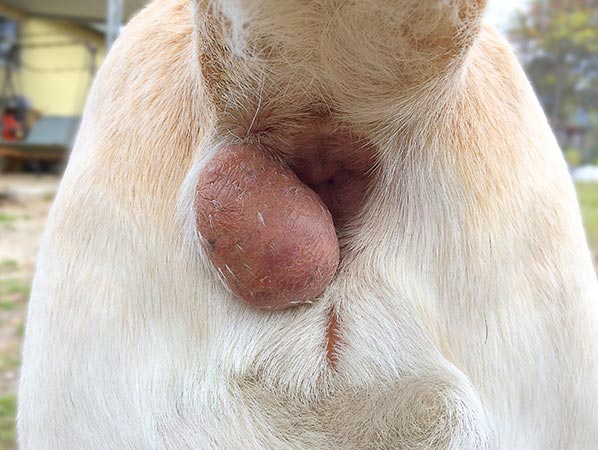
Any bleeding lump on a dog is worrying but those around the bum can be particularly unpleasant – for both you and your dog. As vets it’s not uncommon for us to see bleeding lumps in this area – from anal gland abscesses to tumors, let’s take a look at some of the possible causes.
What are the top causes of a bleeding lump on a dog’s bum?
1. Anal gland abscesses
Many dogs regularly accumulate excessive secretions from their anal glands either side of the anus, but occasionally this can progress into anal gland impaction and abscessation. One or both anal glands may be affected and common symptoms include a strong fishy odour, scooting, pain when defecating, and soreness, pain, redness and even bleeding by your dog’s anus. The glands can become very swollen due to the inflammation, especially if a lot of pus is present; they may subsequently rupture and leave visible ‘holes’ next to the anus. View this picture showing burst anal glands.
These abscesses are incredibly painful and your dog should see a vet urgently if you suspect one as they will require treatment, including pain relief, antibiotics and possibly flushing of the area under sedation. The prognosis is fairly good but treatment may take several weeks.
2. Anal gland tumors
The anal glands may also develop lumps associated with tumors. Benign tumors (adenomas) can occur in this region but typically don’t cause irritation or bleed. Anal gland adenocarcinoma is the main tumor associated with the anal glands – this is a malignant tumor that can be very aggressive, so it’s important to get any lumps in this area checked out as soon as possible.

Other tumors can also occur around the bum, just like the rest of the skin. Tumors that bleed are unfortunately often malignant, like mast cell tumors, but it is possible that trauma to a benign lump may also cause bleeding. It’s best to get it checked by your vet for a definitive diagnosis.
3. Infections
Infections can affect any area of skin, including the bum. Bacterial skin infections cause little bumps and pustules as well as reddened skin and irritation; bleeding may occur if your dog overgrooms the area.
Larger abscesses can also develop, for example if a small wound becomes infected; these can rupture and ooze bloody pus and discharge.
Infections are typically very treatable but the treatment will depend on your dog’s specific condition. It’s best to see a vet sooner rather than later as more severe infections can require more complex treatment and take longer to resolve.
4. Trauma
Any kind of trauma to your dog’s back end – from another dog or a fall, for example – could cause swelling and bleeding to develop. If your dog has a wound that’s more than a simple graze it’s worth seeing your vet. Any type of bite wound should always be assessed thoroughly as they’re often more severe than they appear and may need flushing and examination under sedation, and possibly antibiotics to prevent a severe infection.
5. Rectal prolapse
Occasionally, we see patients present with a rectal prolapse, usually after excessive straining to toilet. The tissue of the rectum, just inside your dog’s bottom, is pushed out through the anus. The tissue is often red and inflamed looking, which can worsen over time, especially if it’s traumatized or licked. Eventually the tissues can start to die and break down if blood flow is restricted for too long, with the color changing to purple, blue or even black. View this picture of a dog’s prolapsed rectum.
A rectal prolapse should be seen by your vet urgently – the earlier it’s diagnosed and treated, the better the prognosis. Prolapsed tissue is usually replaced under general anaesthetic and a suture may be placed to keep it in position; if the prolapse is severe, this can be difficult and if any tissue has died further surgery may be needed. Your vet may also want to perform further tests to try to establish the cause of the prolapse in order to reduce the chance of recurrence.
Signs that you need to see your veterinarian
Any form of bleeding lump on your dog’s back end is a good reason to see your vet relatively quickly. If the bleeding is severe, your dog is in pain or you suspect a prolapse, you should see your vet urgently.
What will happen at the vet
Your vet will assess your dog thoroughly, potentially including a rectal examination. If an anal gland abscess is present, this may not be possible as they can be too painful. Depending on the suspected cause of the bleeding lump, your vet may recommend:
- A fine needle aspirate to sample any masses
- Medication – for example, antibiotics and pain relief
- Sedation or general anesthetic to explore any wounds, flush the anal glands or replace a prolapse
Disclaimer: This website's content is not a substitute for veterinary care. Always consult with your veterinarian for healthcare decisions. Read More.


Be the first to comment